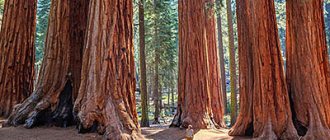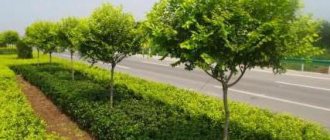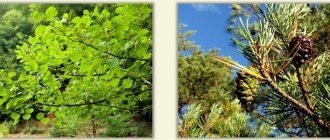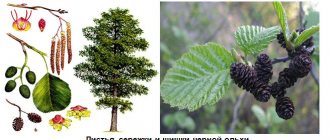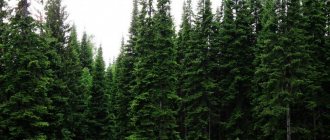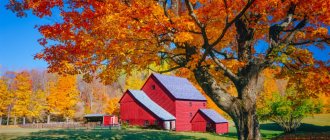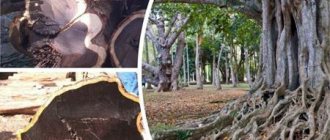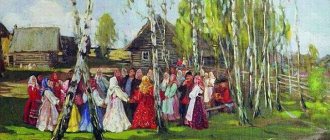Is elm a tree or a shrub? Description of the plant and photo
Elm is a common name for several species of elms in the southern regions of the country. The name comes from the Turkic “ebony tree”. This is a relict plant that can exist for several centuries.
Mostly, an adult elm looks like a tree, reaching a height of 40 m, but there are also some species that look like shrubs.
Characteristic features of this breed include:
- The surface of the bark of a young branch is light brown without roughness. Only over time do vertical grooves appear on the bark;
- The tree is unpretentious and can grow even on infertile shaded soils, although it feels better on fertile soils. Be that as it may, it grows quite quickly; in a year it adds 50 cm in height and increases by 0.3 m in trunk circumference;
- The foliage of the plant is oval with jagged edges, reaches 4-20 cm in length. On the branches, the leaves are arranged alternately on short cuttings;
- The root is powerful and can penetrate the soil 30 m with a trunk whose girth is one and a half meters. However, the roots of some species do not grow in depth, but in breadth and spread over large areas;
- Flowering occurs in spring, before foliage appears. The flowers are collected in small yellow inflorescences;
- The fruits are small winged nuts that ripen in May. Such seeds, once on the soil, can germinate within a few days.
You can meet it both in the form of single representatives and in mixed plantings.
It is noteworthy that it is widespread not only in the wild, but is also in demand in landscape design.
Elm tree - diseases
If weather conditions are incorrect or agricultural practices are not followed, the plant may be affected by the following diseases or insects:
- Dutch fungus
. As a result, the blood vessels in the branches or trunk become clogged, and the leaves dry out. There are no treatment methods. - Shield
. It attaches itself to branches and gradually sucks the juices out of them. Small pimples on the branches indicate their presence. To get rid of the elm tree, it is treated with special chemicals. You can use the following insecticides: “Iskra Zolotaya” or “Aktara”. - Bark beetles
. They penetrate under the bark and feed not only on the sap of the tree, but also destroy the integrity of the wood. The following preparations are used for treatment: “Confidor Extra” or “Clipper”.
Varieties and species, distribution area, where it grows in Russia
The name “elm” hides two types of elms common in Russia.
These include:
- Small-leaved - found in the south of the Asian part of Russia. It grows up to 15 cm in height with a dense tent-shaped crown. The branches are thin and often spaced. The plant tolerates replanting well and lends itself well to formative pruning. Blooms in March, fruiting is expected in May;
- Squat - often found in western Siberia. It reaches a height of 25 m with an adult trunk diameter of a meter. In regions with a dry climate it can grow as a shrub. The bark of young sprouts is smooth, with a gray tint, but gradually it becomes coarser and breaks through in places.
In the natural environment, these species can be found in the southern and western parts of Russia. However, you shouldn’t be surprised to find them somewhere in the park.
Elm tree - types
There are 10 different representatives of elm growing in our country. Almost all of them are long-lived, reaching an age of 250 years. The most common types of elm trees are:
- Ordinary
. Height up to 25 m, trunk diameter up to 1.5 m. The bark is dark brown and the leaves are dark green. The flowers are small brown-violet. Used for landscaping parks and local areas. - Squat
. Maximum growth is up to 15 m. They often form shrubby forms. The foliage is soft green and leathery. The inflorescences are small yellowish-brown in color. They do not like shaded areas, but at the same time they create dense shadow. - Lobed
. A Far Eastern species with large leaves of an original shape. The height of the trunks is 25 m, the crown is dense and cylindrical. Grows on mountain slopes. - Rough
. Found in deciduous forests of Europe. Height is about 35 m. The crown is smooth and dark brown. The leaves are large and light green. Life expectancy is about 400 years.
How to plant and grow small-leaved elm
This is a fairly unpretentious plant, which is not at all difficult to get into the garden.
In order to grow a tree you need:
- Plant the seeds in fertile, loose soil in a small container. At the same time, you should not deepen them too much; a few millimeters of depth is enough;
- Be sure to add lime to the soil to enrich the soil with phosphorus, calcium, nitrogen and magnesium;
- In the first few weeks after planting, it is important to maintain stable soil moisture. To do this, it is recommended to cover the container with polyethylene and do not forget about watering;
- The first shoots will appear in a week.
However, it is not at all necessary to grow it from seeds; you can use the cutting method. To do this, it is recommended to cut the cuttings in May and, after treating them with growth stimulants, place them in water to form roots.
Let's watch an interesting video about how to grow a kargach tree:
Features of elms
Elm is a tree that, when planted on fertile soil, spreads its roots over a considerable distance, due to which they sometimes reach the level of groundwater, providing the plant with nutrients even in conditions of severe drought.
Elm propagates by seeds, which must be planted in the soil immediately after ripening (late May). If planting is delayed for any reason, the seeds lose their quality and are no longer suitable for sowing. With sufficient soil moisture, the germination process takes no more than 1 week.
Young trees grow in all directions and resemble bushes in their shape. This happens because at the initial stage of growth they lack a vertical shoot from which the trunk is formed. However, with age, its shape evens out, and the bush becomes more and more like a tree.
It is noteworthy that a fully formed tree begins to bear fruit 10-12 years after germination.
Features of care, requirements for lighting and soil moisture, pruning
Like any other plant, after germination, elm needs some care.
The latter consists of following a number of measures:
- Watering is regular at the beginning of the growing season and limited after pruning. The soil should not be allowed to dry out;
- Fertilizing depends on the type of soil. So if the soil is rich in nutrients, special fertilizers may not be needed at all. However, if the soil is not rich, it is recommended to apply organic fertilizers (unrotted weeds and compost) once every two weeks. In addition, it would not hurt to add an equal mixture of rotted compost, sand and crushed stone;
- Crown trimming - the optimal period for crown formation is considered to be from January to April. The essence of shaping comes down to cutting off too densely growing branches and giving the crown the desired shape using wire. It is important to ensure that the wire does not grow into the branch. To prevent this, it must be removed after a year.
Elm is a fairly hardy plant that does not require special care. The tree tolerates pruning well and is able to grow even in unfavorable conditions, although in this case its appearance will suffer.
How to get rid of an elm tree?
With its beauty and benefits, sometimes situations arise when you need to get rid of a plant. An easy way is to cut or dig, but in some situations this is not possible. In this case, the elm elm is removed using a chemical method. To do this, you can use watering, spraying, grafting, introducing the drug into the soil, or applying it to the bark. Among the well-known ones are the following: “Sodium nitrate”, “Ammonia nitrate” or “Arsenal”. Alternative methods include:
- Use of salt. Watering is carried out with a concentrated salt solution. The larger the tree, the greater the quantity required.
- Root tiling. They are filled with concrete to the very foundation. This leads to a blockage of oxygen and moisture. On average, the roots die after a month.
- Shutting off the air supply with mulch. A layer of mulch 15 cm high is laid over the roots. The same is done with the trunk. This partially blocks the supply of nutrients, which leads to death.
When and how to bloom, use of fruits
Yellowish small inflorescences appear in early spring and remain on the branches for ten days. After flowering, by the end of May or even the beginning of June, you can expect the formation of fruits.
The first fruiting occurs after its seventh birthday. Typically, fruiting is quite abundant; one plant can produce about 30 kg of nuts per year.
The fruits are round, collected in groups, located on long stalks. At the core of each fruit is a nut.
Despite the fact that elm is better known for its wood and bark, there are also references to the use of its fruits. So in folk medicine, the fruits are boiled in milk and used to treat gonorrhea.
Characteristics of elm
To understand what an elm tree looks like, you need to familiarize yourself with its main characteristics. Karagach is considered a large, strong, hardy tree and is capable of reaching a height of up to 30 meters, and the trunk volume is more than 1.3 meters in girth. Its leaves are beautiful, carved, large.
The tree loves abundant, scorching sun and a lot of warmth, and in its luxurious shade you can hide from the sweltering summer heat. In its historical homeland, it can survive many human generations, since its life cycle lasts up to 300 years.
The appearance of the elm tree inspires undoubted trust and respect. Thanks to its powerful root system, going up to 8 meters deep into the earth, with partially superficial roots, no hurricane can cope with it. Cork growths sometimes form on its trunk and branches. The bark of the trunk is rough, very rough to the touch.
Looking at the photo of an elm tree, one cannot help but notice the light green flowers that stick around its branch like little roses. The flowers are so interesting that when you see them for the first time you will want to know even more about the tree itself.
Elm usually blooms at the end of April and blooms until the end of May. If you break a few flowering branches, you can decorate your home interior with them. The fruits of the elm tree begin to ripen after flowering ends. Visually, they look like miniature plates containing seeds inside.
For example, in China, unripe elm seeds are added to food, and they are considered not only tasty, but also healthy. In southern and sunny regions, elm can be found in gardens or parks, where passers-by rest under its spreading crown in the heat. Already at the beginning of autumn, the leaves of the tree become rich yellow and it looks very elegant.
Medicinal properties
Due to the rich chemical composition, the leaves and bark are widely used in medicine. Often the bark is collected during the flowering period, and the foliage in early summer, always in dry weather.
The collected material can be used to prepare decoctions and infusions for several years.
In folk medicine it is used in the cases indicated in the table.
| Composition of funds | Application area |
| Bark decoction | For the treatment of bladder inflammation, diarrhea, edema, pathologies of the gastrointestinal tract. To accelerate muscle healing and treat certain skin pathologies |
| Leaf decoction | For wound healing and colic relief. An infusion of elm bark, willow and birch buds is used to treat colds and fever. |
| Infusion of elm bark, willow and birch buds | For the treatment of colds and fever. |
The spread of preparations based on elm leaves and bark is due to the large amount of tannins and mucus that are included in their composition.
They have a beneficial effect on the human body in case of damage to the skin and diseases of the digestive system.
Application of elm
Products made from elm are incredibly beautiful. Craftsmen are not afraid of its density. Its trunk does not rot or crack, and the wood has unique flexibility. Its growth rings are perfectly visible, which is especially valuable in finished products during processing.
The color of the trunk is not only beautiful, but also has a chic silky shine. Because of all these positive qualities, elm is very loved and appreciated by connoisseurs of tree species.
It should be noted that in addition to positive qualities, there are also negative ones. The tree trunk is labor-intensive to sand and paint. It has an aroma that does not have a very beneficial effect on the human body.
In addition to furniture, household tableware is made from elm, such as spoons, ladles and cups. And the bark of the tree itself was intended for leather tanning. In addition to all this, the bark served as a medicine in the treatment of burns and eye diseases.
From wood growths (otherwise called papa or suvel) of elm, craftsmen and masters of folk crafts create real masterpieces of household utensils and extraordinary, intricate figurines and figurines of various animals. Such works of art cost a lot of money and their production takes months of painstaking work.
Wood, cut photo, price, how to use it, elm products
Elm wood is especially highly valued in industry. It practically does not rot even at high humidity.
This feature allowed elm to become especially popular in Europe, where it was used to make water pipes and build bridges.
Elm is a very dense wood, which makes its processing quite difficult. When cut, the tree has a beautiful texture with a light brown core and a soft yellow subbark.
Despite the difficulties that arise when cutting, the wood is polished quite easily, plus it glues perfectly and does not crack when dried.
On average, it is difficult to find wood of this type for less than 35,000 rubles/m3. Elm is widely used in the furniture industry, shipbuilding, flooring, and decorative elements.
Products made from elm are characterized by increased resistance to moisture and sunlight. That is why, despite the complexity of processing, elm wood does not lose popularity.
Let's watch an interesting video about the use of kargacha wood:
Karagach - acquaintance and first job
Good autumn day, dear Friends, Guests, Buyers and Customers of my store! Today I present to you my new work - “The Legend of Prato” - a tray made of solid elm (elm, elm) wood.
An unfamiliar name for a tree, right? So my acquaintance with him took place quite recently. When I was offered to take on an array of elm along with other materials, my thoughts ran in different directions. On the one hand - something new and interesting - there are so many photos of beautiful products from this array on the Internet, and on the other hand - what kind of animal is this, how will it behave at work, will it accept tinting and will it make friends with the pyrograph?
The tray arrived - and the first thing that struck me was the extraordinary tart, attractive and at the same time independent aroma of wood. “You, my friend, have character,” I thought, continuing to study the future tray. And in addition, I was pleasantly surprised by the lightness and simultaneous strength of the solid wood and its chic wood pattern.
The fairy tale itself began yesterday with the sound of rain outside the window and a round dance of autumn leaves... time stood still... I was doing work and could not tear myself away - how enchanted I watched how the tree changed its color when tinted with herbal decoctions and with what gratitude it accepted the fire of the pyrograph. A truly unique, grateful tree with amazing warmth and energy.
Elm is a deciduous tree of the elm or elm family, growing in the Crimea, the Caucasus and Central Asia. Trees of this species are about 40 million years old. Tree wood has similar characteristics and is used in the same areas. Karagach is the Turkic name for small-leaved elm. The tree can reach 40 meters in height, and the girth of the trunk of such specimens can reach up to 2 meters. The average lifespan of trees is 80-120 years. In favorable conditions, there are also long-livers who live up to 400 years. In its properties, elm wood is close to oak. It is strong, dense, has high viscosity, bends and resists well, and can be processed well. In terms of wear resistance, elm is not inferior to beech and ash. The resistance of elms to rotting in water has long been known. Their wood was used for piles in the construction of bridges across rivers and for laying the lower rims of wells. In the Middle Ages, Europeans made water pipes from tree trunks with a hollowed out core. It is still used in mines and in the construction of hydraulic structures. In shipbuilding, it is used not only for finishing cabins and salons, but also for the manufacture of ship hull parts. Some buildings in Venice stand beautifully on stilts made of elm.
Elm wood, light with a yellow tint, has clearly visible growth rings and has a silky shine. The texture is visible in both longitudinal and transverse sections. These properties, as well as flexibility after steam treatment, are valued by furniture makers. Burls often form on the tree trunk. Their wood is highly valued as a finishing material, as well as a material for making art products, as it has a very beautiful texture.
Elm was widely used, and is still used, by woodcarvers and cabinetmakers in Central Asia and Turkey. It was not for nothing that the Central Asian khans and Iranian shahs loved to relax on carved sofas - the fact is that this wood, even in its processed form, emits a tart, subtle aroma that has a relaxing effect on a person. Today, furniture made from this species is, oddly enough, a rarity, but connoisseurs still appreciate the aroma of the East that hovers in a room where there are interior items made from elm. Even the final product made from this tree emits an aroma that acts as an antidepressant on humans.
Enjoy your viewing and happy autumn!
Sincerely yours, Lena Polovinkina.
Elms in landscape design
All elms grow very quickly. So, already four years after planting, you can get a fairly decent tree from a small cutting. If a small tree has already been planted, you can safely expect an annual growth of one meter.
It is thanks to its growth rate that it received special appreciation from landscape designers. Since this plant tolerates pruning very well, after which the crown thickens quite quickly, it is often used to form a hedge.
However, this tree is used not only to form fences, but also in other compositions. So elm looks quite impressive on the lawn when planted alone and also fits harmoniously into the rock garden. The tree will not get lost even against the background of low bird cherry and mountain ash, and it will not become a stranger next to apple and cherry trees.
Thanks to the spreading crown, which can cover a fairly large area, shade-loving plants can be planted under the tree. In landscape design, elm is often planted with ferns, lilies of the valley and bergenia.
What else, besides the speed of regeneration and active growth, can attract landscape designers to elm? Its foliage. Despite the fact that this is a deciduous tree, with cold weather it is in no hurry to get rid of its foliage. At first, the plates acquire a yellowish-olive color and fall off only with severe frosts.
Considering all these advantages, it is not at all surprising that it is found even in those areas where it has never existed in nature. And even if it takes more time and effort to grow a tree there, it is worth it.
Planting and care
Planting elm in the local area is not difficult. You will need ripe, dried seeds. Shoots appear a few days after immersion in the ground. It is important to remember that germination quickly disappears, so it is important not to waste time. Elm fruits should be planted according to the following algorithm:
- It is necessary to collect the seeds after flowering has completed. After this, they are placed in nutrient soil or wet cotton wool. It is advisable to pre-treat the fruits with anti-fungal agents.
- After a few days, the seeds are planted in a container with soil. The best choice in this situation would be black soil, as this will increase the growth rate. But humus with leaves will also work. Be sure to choose a soil that is soft and sufficiently moist.
- The seeds are immersed to a depth of 1-2 cm, the distance between the holes should be approximately 25 cm. The ground is covered with moss, dry grass or cotton wool. The soil is moistened every day. After 10 days, you can see the young elm and remove the covering material.
It is advisable to frequently place the sprouts in the sun. In the absence of precipitation and wind, it is good to leave the container with young sprouts on the balcony or in the garden in the air. During the first year, the plant reaches 20 cm. The seedling can be planted in the ground in the second year.
In the first years, elm must be protected from excessive wind and low temperatures. For the winter, the tree must be covered with special material. It is important to remember that soil saturation affects how roots form, so poor soil needs to be fertilized. It is also important to regularly loosen the soil around the shoot.
Over the course of a year, the elm grows 40-50 cm in height. The branches are not pruned for 1-2 years; the crown is required to form. Only diseased or dry branches should be removed. It is permissible to trim the crown while the seedling is growing.
What does the tree symbolize?
Like many other plants, elm is also noted in the beliefs of different peoples. He is often associated with Mother Earth. In some legends, this amazing tree has become the home of fairies, which should not be touched by curious travelers.
However, the most popular symbol that the elm represents is dignity. The width of the outstretched crown and the height of the trunk indicate faith and support.
Based on this, it is not surprising that amulets are often made from elm wood. One look at this majestic giant is enough to understand that our ancestors had every reason to attribute to him a symbol of dignity.
Karagach is the popular name for several types of elms, common in the south and west of Russia. Known in folk medicine and widely used in landscape design, it is used in the furniture industry due to the special strength of the wood.
Properties and uses of wood
In terms of density, dry elm wood is close to birch - 550–600 kg/m³. It has a beautiful noble texture with a pronounced natural pattern. The heartwood is light brown, the sapwood is pale yellow. Elm materials are characterized by high hardness, are resistant to rotting and deformation, and have high resistance to impact loads and compression.
Due to its high density, elm is difficult to saw, split and other types of processing, but bends quite well. The smooth surface of the material tolerates polishing well. Fresh timber practically does not crack or warp when dried.
Elm has long been used for the production of bows, wheel rims, rocker arms, and wooden parts of harnesses. Dishes were hollowed out from the massif. In London, Venice and other European cities, bridge supports were turned from elm wood, and it was used in the construction of river dams, locks, and the construction of mines and cellars.
Currently, elm is used more in the form of veneer, which increases artistic value and ennobles lower-quality wood species, or as part of combined materials for interior decoration. Elm materials are used for the production of parquet, wooden frames, panels and handles, baseball bats, furniture parts, blanks and products that require bending.
